|
| Author |
Message |
Coach v
Member
|
# Posted: 18 Jan 2018 17:45
Reply
My good friend recently purchased a homestead from a older gentleman who had passed away. The property has many buildings with work spaces and living quarters. It is deep in the woods and NOTHING is permitted and most is not finished. I am sure I will have a lot of questions, but we want to tackle the auto-start right now.
I am working on figuring out the off-grid power system. It has a small solar system, a diesel generator, a 24volt battery bank (3 banks of 4- batteries), 2 trace inverters, and a solar controller( I think). The system mostly works, but some of the auto start wires were ripped out and cut assuming by his family who didn't know or care about the system. The programming is already setup close to our liking, at least initially.
It is a Mitsubishi generator with a SDMO panel. Is there a place to source a manual for the generator? Or perhaps some assistance on where to hook up the auto start wires (the run wiring is hooked up, just not the cranking wires)?
Thanks,
Michael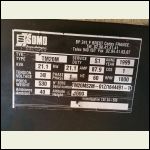
20180114_104553.jpg
| 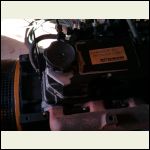
20180114_104617.jpg
| 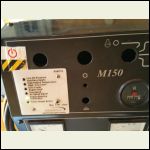
20180114_104539.jpg
| 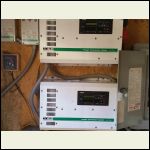
20180114_104625.jpg
|
|
|
Coach v
Member
|
# Posted: 18 Jan 2018 18:30
Reply
I can find a manual for the actual Mitsubishi generator, but I need to know what I am doing inside the SDMO panel that is attached to the genset. That is where the auto-start wiring hooks up.
|
|
DaveBell
Moderator
|
# Posted: 19 Jan 2018 00:46
Reply
Nice 18 year old french generator.
Can you open the M150 panel to see if the manufacturer glued a wiring diagram to the inside. I've seen them do that on laundry washers and dryers.
Can you post close up pictures of all the individual units on that wall? Don't need the Trace unit. Curious about an external control unit. Some of the current SDMO manuals mention "external command".
|
|
Coach v
Member
|
# Posted: 19 Jan 2018 01:16
Reply
We did open up the m150 panel. Unfortunately, no wiring diagram. We were hoping it would be easy to see where the "crank/start" wires went, but there was quite a bit in there. The "run" wire is correctly hooked up in the inverter and we assume that it is correct in the m150. The "crank" wiring is correct in the inverter but disconnected and loose at m150. We have the inverter manual and feeling decently comfortable with it for rookies.
Here are the individual components. These are all the photos I have of it at the time. I will be back out in a few weeks, weather permitting.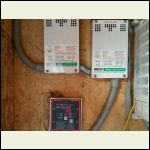
20180114_104640.jpg
| 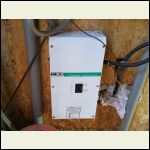
20180114_104645.jpg
| 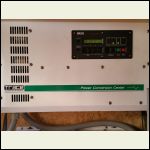
20180114_104635.jpg
| 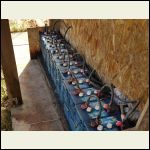
20180114_104653.jpg
|
|
|
creeky
Member
|
# Posted: 19 Jan 2018 10:30
Reply
There may be a reason he was running his charge manually.
Lots of nice equipment there. But those batteries. If they've been sitting at 45% charge. They're probably ready for the recycler. And if nothing else. I would scrub the terminals. I see some corrosion.
I'll assume the wet areas are because you just watered them.
But you certainly seem to have the basis of a solid solar system there.
|
|
Coach v
Member
|
# Posted: 19 Jan 2018 13:13
Reply
You maybe correct about him having a reason, but it is definitely something we want operational. We know that the inverter system works and that the generator works. I do have battery concerns, but that comes later.
The system is definitely not sized for the load. The property has 7-8 separate living quarters (some approx 1200-1500 sqft) , a wood shop, auto shop, plus well house. Just the lighting is ridiculous. The 20x40 woodshop has over 2000 watts in just lights. The living areas have huge lighting as well (there is a chandelier with 10 one hundred watt bulbs. We have been unscrewing bulbs and replacing many with led. We are burning about 5 gallons of diesel a day when we are out there partying nights and working days. There is a full 500 gallon diesel tank we want to burn through (sort of).
|
|
rachelsdad
Member
|
# Posted: 19 Jan 2018 14:25
Reply
Gotta love the LED's huh?
Sorry I can't answer your question but:
Are those batteries sitting on concrete?
|
|
ICC
Member
|
# Posted: 19 Jan 2018 14:41
Reply
Quoting: rachelsdad Are those batteries sitting on concrete?
That does not matter. "old wives tale"
https://www.homepower.com/articles/solar-electricity/equipment-products/ask-experts-b atteries-concrete
|
|
|
rachelsdad
Member
|
# Posted: 20 Jan 2018 10:48
Reply
Wow...I had no idea.
You have to see the gyrations I go through to store all of my various batteries in my basement...OFF the concrete floor.
Thanks for the link. Learn something new every day if you ask questions huh???
|
|
Steve_S
Member
|
# Posted: 21 Jan 2018 09:41
Reply
There is one point not mentioned in there I believe... Like where I live, we see -30c /-22f temps (or worse) and in summer up to 36c/100f or more too. Summer the batteries don't need the heat, so keep'em cooler. In winter, concrete floor = heat sink and that cools the batteries which is not good. To that end, my bank sit's on a 4" thick pad of HD-XPS foam, so not directly on concrete... Only to make sure they do not pull cold from the floor, as batteries much prefer stable temperatures. Cold Floors are NOT good for batteries, just like leaving them sitting in a snowbank is bad for them too.
FYI: I have my batteries / solar system in the Pump/Powerhouse 50' from cabin. That building (80 sq feet) has a frost protected slab floor and is also hyper-insulated with XPS & ISO foams, no windows. It's kept warm in winter by an old direct vent RV Propane Furnace that only needs 12v for the fan. and is set to 5c/41f.
|
|
|

